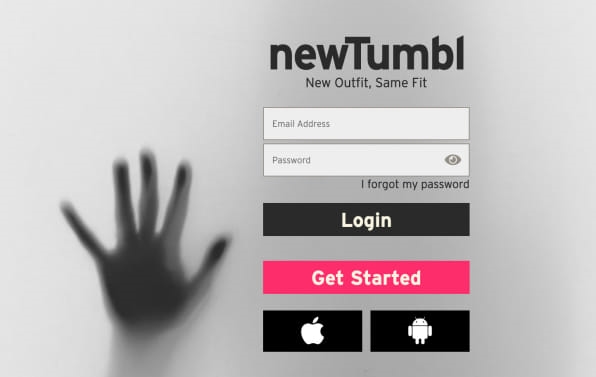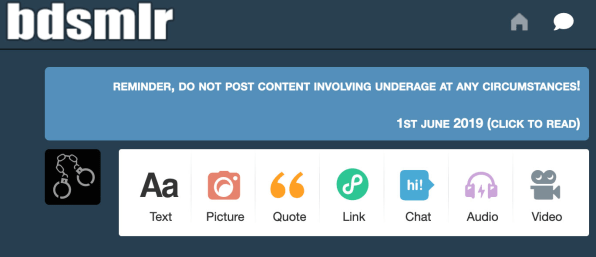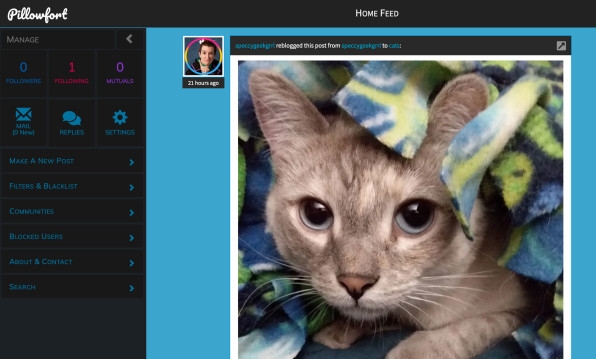After Tumblr’s NSFW ban, these adult communities have come out on top
Once upon a time, a free blogging platform called Tumblr was the online haven for porn, kink, bondage/domination, and other legal but not-safe-for-work communities. That all changed in November 2018, when Apple removed Tumblr from its App Store after finding that child pornography had slipped onto the site.
That kick-started Verizon-owned Tumblr to enact a policy change it says was already planned: a blanket ban on virtually all “adult content” images and videos (but not text)–starting on December 17, 2018. The ban prohibited not just hardcore porn, but even the humble female nipple. (Imagery that just barely hides private parts seems to still be allowed.)
Meanwhile, Tumblr’s web traffic has–er, tumbled. From the pre-controversy month of October 2018 through April 2019, it’s dropped by about a third–both in the U.S. and internationally, according to analytics firm SimilarWeb–from 558 million to 376 million monthly visits globally. That’s despite Tumblr’s return to the App Store in December.
Tumblr’s naughty heirs
Like a fire that clears out miles of forest, Tumblr’s porn ban has created an ecological niche for new not-safe-for-work (NSFW) friendly sites to take root. Natural selection has weeded out many of them, such as the flopped Cumblr. But at least three other sites appear to be blooming.
Obvious warning: Many of the following links lead to NSFW content.
“I knew Tumblr wasn’t that complicated,” says Dean Abramson, chief architect at online gaming startup Statabase. (That’s gaming as in gambling, such as online poker.) “I said, you know, we could rebuild Tumblr, in what, two weeks? Three weeks? At least for the front end. Let’s give it a shot.”
Abramson and his colleagues’ side project, newTumbl, opened to the public on December 16, and now has over 200,000 users, he says. The site had about 2.2 million global visits in April, according to SimilarWeb (the latest month for which it has data). For perspective, that’s about 1.2% of just what Tumblr’s lost since October.

[Image: newTumbl]
Still, it’s a long way from zero visits in December, and more than some other sites have experienced. For instance, xstumbl, also founded in December 2018, had about 45,000 global visits in April, per SimilarWeb–down from its peak of about 109,000 in January. Site owner Andrew Kunkle tells me that the site has about 20,000 users, despite spending “$0 on advertising.”
Like the original Tumblr, newTumbl isn’t meant to be exclusively for porn sharing. “We would like to be a complete site, from kittens all the way up to anything legal,” says Abramson. (All of these sites make clear that posting illegal content, such as child pornography, is prohibited.) “But we know that right now, probably 90% of our users are here for adult content.”

[Image: courtesy of Sharesome]
In comparison, a startup called Sharesome has focused on adult content since its launch in January 2018. It’s reaped similar growth, from roughly 79,000 to 2.7 million global visits from October to April. (Sharesome quoted me an estimate of 3 million visits for May.) “We have pornstars, cam models, illustrators, writers, amateur kinksters, cosplayers, and so on,” wrote Sharesome CEO Tudor Bold in a Twitter DM conversation with me. “They’re all welcome on Sharesome to post both NSFW content (our bread and butter) and SFW content they may enjoy.” The site has about half a million users, says Bold.
Sharesome can also import old Tumblr blogs. Tumblr allows users to download all of their content to an archive file. The company says it only hides adult content from public view (a slow, ongoing process), rather than deleting it from the database. So blog owners can still access all the original files. Sharesome is one of several sites with the ability to upload those archives. (newTumbl says it’s in the works.)
Tumblr imports are also possible on BDSMLR, which may be the biggest winner yet of Tumblr’s NSFW ban. It originally focused–as the name implies–on the bondage, dominance, sadism, masochism, and related fetishes. But BDSMLR has grown rapidly into a universal porn site, going from about 87,000 global visits in October 2018 to 9.4 million in April. (I made several unsuccessful attempts to reach the people who run BDSMLR.)
All these startups are miniscule compared to NSFW behemoth Pornhub, which reports over 110 million daily visitors. In early May, the Wall Street Journal reported that Verizon is looking to sell Tumblr, which it picked up in its acquisition of Yahoo in 2017. Pornhub’s vice president Corey Price told BuzzFeed that the company was “extremely interested” in buying Tumblr.
Verizon didn’t respond to my inquiry. PornHub didn’t say more about a possible Tumblr acquisition, but emailed a long statement making its case for already being an NSFW haven. “The same curatorial options are available on Pornhub as they were on Tumblr and users can enjoy the same personalization with us, including the ability to customize their personal feed, create playlists, generate GIFs, and more,” it said.
Tumblr clones–for now
newTumbl and BDSMLR closely follow the Tumblr design: Users can quickly start their own post using text, photos, audio, or video. (GIFs that continually loop through the action dominate posts on all these sites.) They can also search on anything–really, anything–that catches their fancy to find other blogs or posts.

[Image: BDSMLR]
A freewheeling content policy can have disturbing downsides. A blog on BDSMLR called EroticPatriarchy features posts with titles like “happy girls know their place” and “Being raped made me support the patriarchy more.” Over at newTumbl, Abramson says that the site will take a hands-off approach to offensive speech, such as anti-Semitism, unless it crosses over to personal attacks on fellow users or calls for real-world violence.
By following a few blogs, BDSMLR and newTumbl users can queue up pretty intense action to greet them as soon as the sites load. Abramson says that newTumbl will soon implement an “explore feature” that asks new users about their interests (beyond just kink) and guides them through content suggestions. (Abramson says the site will likely change and grow a lot as it evolves beyond just an NSFW Tumblr refuge, and a name change is also coming.)
Sharesome gets content in your face even sooner. It features something like a Facebook news feed of the most popular posts–regardless whether or not you follow the posters. It also lists suggested topics (as varied as Threesome lovers, Bi Swingers, Gay Cowboys & Farmers, and so many others I best not name here) as well as suggested members to follow. Many posters are amateurs with just a handful of followers, offering free content that is sometimes adorably awkward. But those with hundreds or thousands of followers typically use their profile as a teaser with links to other sites where they sell the goods.
Cashing in
Moneymaking is the challenge for all of these sites, and different approaches are emerging.
“We plan to monetize very similarly to mainstream social platforms: with ads,” writes Sharesome’s Tudor Bold in a DM. “For example, models and brands can already boost their profiles so that they reach more people. We will also re-enable promoted posts and we will be adding more options.”
Abramson says that newTumbl has about a dozen ideas for raising revenue, which will start emerging in Q4. He declined to discuss monetization strategies on the record, but said that they will be based on providing users the ability to earn money for their blogs. Abramson reckons the company will take a 20% share of what bloggers earn.
Financial self-sufficiency has slowed the growth of another emerging network, Pillowfort. It opened February 2017 as a general-interest site in the mold of Tumblr and the early-2000s version of LiveJournal. Membership was limited to a few hundred people who had contributed to the site’s first Kisktarter campaign. Pillowfort held a second Kickstarter in August 2018, but really took off with the Tumblr NSFW ban because of its liberal content policies.
“We actually had to close down registration for awhile just because we were getting more people signing up than we actually had the infrastructure to support,” says founder Julia Baritz. Pillowfort has about 47,000 members, but its slow growth is deliberate.
Pillowfort raised a modest $57,000 in its latest Kickstarter. And it charges new members a $5 registration fee, which is “the only way that we [can] pay our server hosting fees and our data service fees,” says Baritz. The site is working on modest ways to bring in money–such as extra blog-customization options–that reflect more of an intimate, user-supported community than a mega entertainment site. Users will also have to pay for uploads greater than a few megabytes. They can already embed any kinds of videos, including porn, from other sites.

[Image: Pillowfort]
That’s not to say that Pillowfort is a porn haven, period. “NSFW” was only the ninth most-popular subject community when I perused the site, behind others like “Marvel,” “DnD,” “Pokemon,” “LGBT,” and, of course, “Cats.” But its managed growth has so far kept the servers on while other post-Tumblr sites have faltered.
“We don’t want to throw open the doors and say, ‘Hey everyone, come party with us,’” says Bartiz. “And then we get a huge bill and we don’t have the revenue stream in place to support it.”
(40)



